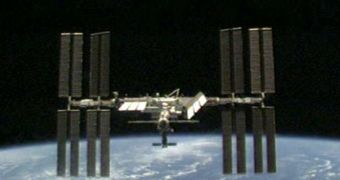Just as the space shuttle pulled apart from the ISS, its cameras recorded the first pictures of the completed orbital facility, with all its solar panels fully deployed. Discovery was brought about in a “victory lap” around the station, and so the first images became available. According to Mission Control, the photographs are worth in the vicinity of $100 billion, the estimated cost of the international science outpost, whose first module was sent in orbit in 1998.
Despite the fact that another segment of the “backbone”-like truss rod structure and a fresh set of solar wings were installed during STS-119 alone, only 81 percent of the ISS is completed. Missions to take place later this year, and in 2010, plan to take another three modules up into orbit, as well as two more mini-modules. NASA's Node3 and the Cupola ones will be ferried up in February 2010, while the Multipurpose Laboratory module will be attached after December 2011.
“It's really just incredible (...) it's almost indescribable. I just feel a great sense of honor to be a part of it, and a great sense of pride in my team. That's certainly a wonderful snapshot. The picture I'm affectionately calling the $100 billion photograph,” Kwatsi Alibaruho, who is the lead space station flight director for the Discovery mission, told reporters on Wednesday. The figure was estimated by Obama's assistants, who communicated to the President the rough costs of the international project while the commander-in-chief was talking to the joint crew on the ISS, just yesterday.
“You always saw it in the pictures, and you just wondered if we were ever going to get there. There's an extreme amount of pride in joy in seeing that,” the head of the station's mission management team, Dan Hartman, who has been working on the ISS project for the better part of 15 years, shared. He added that the orbital facility finally looked at the moment just like computer simulations had shown. Until now, artists' depictions of the completed facility have been the only thing engineers have had to rely on, but now the pictures of the real thing are available, which is like a dream come true.

 14 DAY TRIAL //
14 DAY TRIAL //